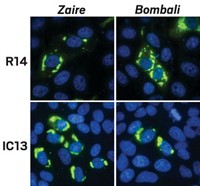Advertisement
Grab your lab coat. Let's get started
Welcome!
Welcome!
Create an account below to get 6 C&EN articles per month, receive newsletters and more - all free.
It seems this is your first time logging in online. Please enter the following information to continue.
As an ACS member you automatically get access to this site. All we need is few more details to create your reading experience.
Not you? Sign in with a different account.
Not you? Sign in with a different account.
ERROR 1
ERROR 1
ERROR 2
ERROR 2
ERROR 2
ERROR 2
ERROR 2
Password and Confirm password must match.
If you have an ACS member number, please enter it here so we can link this account to your membership. (optional)
ERROR 2
ACS values your privacy. By submitting your information, you are gaining access to C&EN and subscribing to our weekly newsletter. We use the information you provide to make your reading experience better, and we will never sell your data to third party members.
Diagnostics
Bacteria Pick Up On Celiac Disease
Medical Diagnostics: A library of peptides on the surfaces of bacteria can capture new antibodies associated with celiac disease
by Erika Gebel
January 2, 2013

Celiac disease, an autoimmune disorder, is notoriously difficult to diagnose, particularly in its early stages. Now, researchers have developed a strategy to capture novel celiac disease antibodies. The technique successfully differentiated between sick and healthy people (Anal. Chem., DOI: 10.1021/ac303201d).
When patients with celiac disease eat wheat or other grains, their misfiring immune systems attack a grain protein called gluten sitting in their intestines, damaging nearby tissue. Immune system proteins called antibodies bind to intestinal tissues, marking them for destruction.
Doctors diagnose celiac disease with blood tests that screen for two antibodies, one that targets gluten and another that goes after an intestinal protein, says Patrick Daugherty of the University of California, Santa Barbara. The tests can identify most people with advanced cases of the disease, but he adds, “We need earlier detection, before people have significant damage in their small intestine.”
To spot celiac disease early, Daugherty and his team aimed to find previously unknown disease-linked antibodies. Their strategy centered on building an enormous library of random peptide sequences to find ones that would bind to the antibodies. The researchers created this library by inserting one billion random peptide genes into Escherichia coli, with one peptide gene per bacterium. Once the genes were expressed inside the bacteria, thousands of copies of the peptides migrated to the cells’ surface. The researchers hoped that some of these peptides would bind antibodies from the blood of people with early-stage celiac disease, but not those in samples from healthy people.
Daugherty thought this approach, with its multitude of bacteria each bearing a different peptide, would be more likely to identify unknown antibodies than are other types of peptide libraries. Those other libraries include fewer members than found in Daugherty’s bacteria libraries, because the amount of space on the surface of the object that displays the peptides limits the number and therefore the diversity of the peptides.
To test their new library approach, the researchers collected blood samples from 40 healthy people and 45 people who had been diagnosed with celiac disease. After purifying antibodies from the volunteers’ blood, the researchers labeled antibodies from half the celiac patients with a green fluorescent dye and the rest of the patients’ antibodies with a red dye. Then, the researchers mixed the peptide-coated bacteria with all the antibodies. The researchers added unlabeled antibodies from the healthy subjects in fivefold excess to block labeled antibodies from binding to peptides found in people with and without celiac disease.
They sorted the cells, collecting only those bacteria displaying both red and green fluorescence. Cells labeled with both dyes, the researchers reasoned, displayed a peptide that could bind to an antibody found in at least two people, one patient from each group. This means, the researchers say, that they these antibodies could be markers for celiac disease.
By subjecting the peptides to additional rounds of screening with antibodies from people with and without celiac disease, the researchers narrowed the bacterial pool down to six unique peptides, all of which do not bind to the known celiac antibodies. The researchers then measured binding between these peptides and the full suite of antibodies from patients’ blood. Based on that data, they used a statistical analysis to conclude that they could identify correctly 85% of people with celiac disease and 91% of healthy – nearly matching the values of existing diagnostic tests.
It’s still unclear whether this method can diagnose celiac disease earlier than existing approaches, but Daugherty says the study demonstrates that “we can create effective diagnostics from scratch.” The method is applicable, he says, to diseases involving the immune system, including difficult-to-diagnose illnesses such as lupus, multiple sclerosis, and some cancers.
George Georgiou of the University of Texas, Austin, is impressed by the novelty of the method and points out that it is more flexible than previous methods that relied on peptide libraries mounted on solid surfaces. “The libraries here are much larger,” he says. “You don’t use the same premade library over and over again. You can alter it as needed,” he says, for instance by inserting new genes into the bacteria.




Join the conversation
Contact the reporter
Submit a Letter to the Editor for publication
Engage with us on Twitter